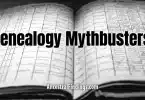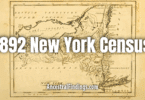The 1940 U.S census is currently the most recent one available to the public, including family history researchers. Current federal law provides for the release of census information to the public seventy-two years after a census was taken. The next federal census, which is the 1950 one, will be released to the public in April of 2022. In the meantime, you have probably explored the 1940 census, as it has been available since 2012.
However, have you made the most of your work with it? Whether you have used the 1940 census before, or are using it for the first time, here are some things you should be looking at to wring every single drop of important genealogical information out of it, which is the goal of every serious genealogist.
Take a Look at Your Ancestors’ Previous Residence
As a genealogist, you probably know the frustration that can come from that ten-year gap in family information between censuses. If your family stayed in the same place for long periods of time, it isn’t such a big deal, but if they moved around a lot, or even just once between censuses, you may have a hard time finding records on them in the places they lived that were not recorded.
This is where the 1940 census comes in handy. It is the first U.S. federal census to list where an individual or family lived between censuses. This census asks where people lived on April 1, 1935. When you know this information, you can look up records on your ancestors in that place, finding out more about them in a way you could not have if you didn’t know where they lived between the 1930 and 1940 census. Using this information to find new local and regional records on your ancestors is invaluable, so do not ignore it.

1940 US Census Blank Form (National Archives)
Was Your Ancestor Hiding Something?
While it did not happen often, sometimes people either refused to answer census questions or did not answer them truthfully. This could be because they didn’t believe the government was entitled to know anything about them, or because they wanted to appear like they were younger than they were, had more education than they did, were from somewhere else than they were, or any number of other reasons.
If a person outright refused to answer a question, despite cajoling by the census enumerator, the enumerator was supposed to write “Refused to Answer” on the census. If the enumerator suspected the answer given to a question was a lie, they were not supposed to record that answer. If you see “Refused to Answer” or a blank box where an answer should be regarding your ancestor, that lets you know your ancestor may have been hiding something, and that you should look further into other records to tease out the correct answer to that question.

1940 US Census Blank Form (National Archives)
Who Answered the Census Questions?
Census enumerators on the 1940 census were instructed to interview the person who was best qualified to give accurate answers to the questions. This meant to always try to interview adults rather than children, lodgers or boarders rather than the homeowner, and to interview the homeowner rather than their lodgers or boarders. If the best person who lived in the household could not be interviewed after the third attempted visit, then another person from the household or a neighbor was to be interviewed about that household instead.
The 1940 census lets you know who in the household, or outside of it, answered the questions for that household. By looking at this information, you can determine how accurate the information given is likely to be (assuming a first choice interview subject answered the questions truthfully, or at all). If you find a person answered who wasn’t as likely to know the correct answers as a more desirable interview subject, you know you should look at other record sources to corroborate those answers to determine how correct (or not) they are. This way, you get the most accurate answers for your genealogy research.

1940 US Census Blank Form (National Archives)
Look at the Supplementary Questions
The 1940 census had a number of interesting supplementary questions that your ancestor may or may not have answered. If they did, you are in great genealogical luck, because the answers to these questions can be extremely informative about your family and its history. Pay attention to the supplementary questions, and your ancestor’s answers to them, if they did answer them. Also, remember that not everyone was asked the supplementary questions for time and efficiency reasons. Only a small sample population were asked them. If your ancestor was asked them and answered them, you have hit a genealogical goldmine on the 1940 census.
Some of the supplementary questions include:
- The birthplace of the interview subject’s parents
- The language they spoke at home as a child
- Whether or not they are a veteran, wife or widow of a veteran or an under-18 child of a veteran, and which war and branch of the military in which the veteran served.
- Whether the interview subject has a Social Security number and if they had deductions taken from their paycheck the previous year for the Social Security “old age insurance” program or railroad retirement.
- Their current occupation
- The number of marriages, age at first marriage, and the number of children for of-age women in the household.
As you can see, there is a lot of hidden information to be mined in the 1940 census. If you look carefully at these things, you can add a lot of valuable information to your family tree. In addition, the 1940 census has information on it that can lead you to other valuable family tree records in other locations and repositories.
Just pay attention to the answers and follow the clues to the record trail. The 1940 census is quite a detailed one when you look at it closely. Mine its deep gems, and let it lead you to valuable genealogical gold.






